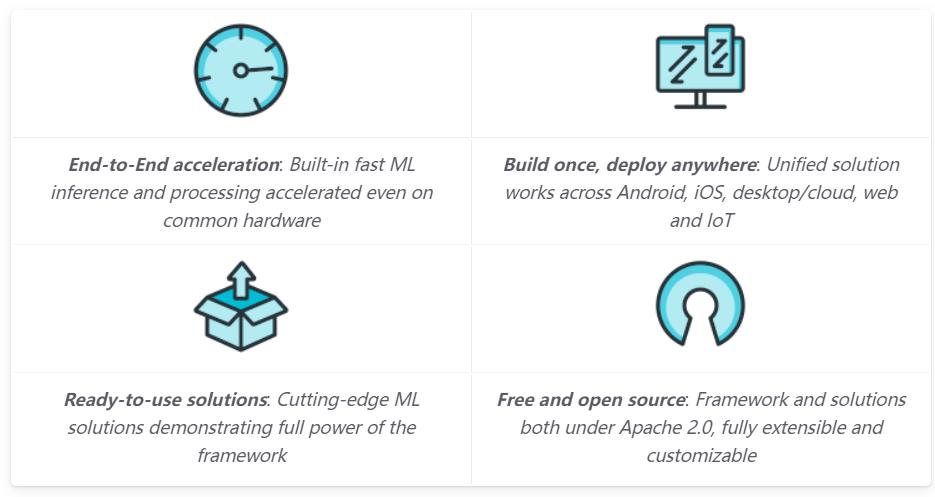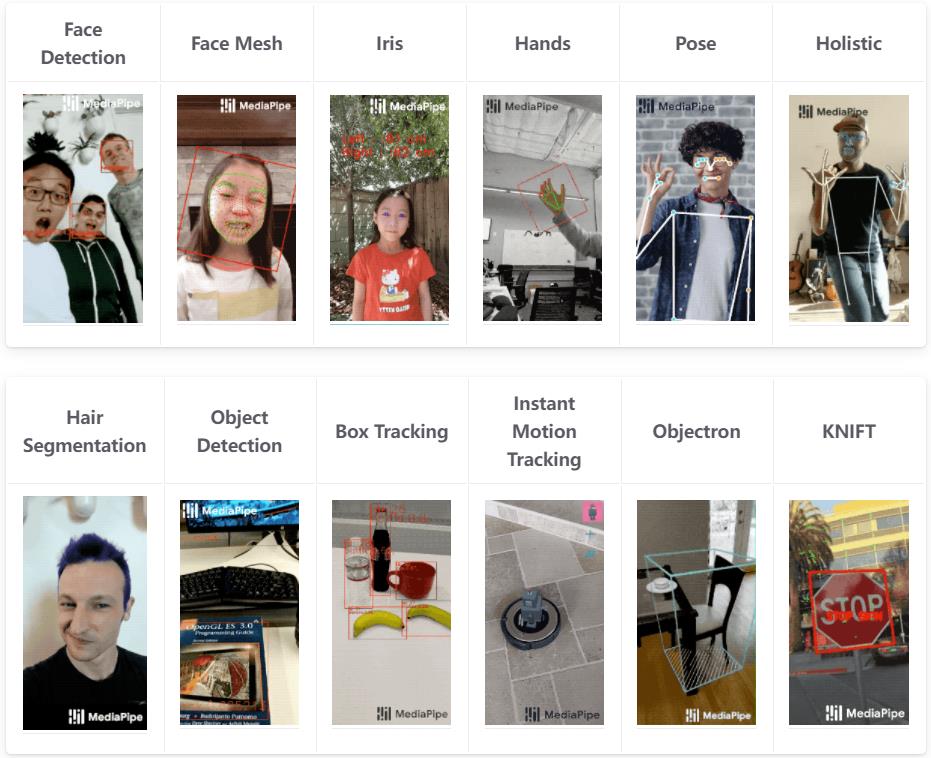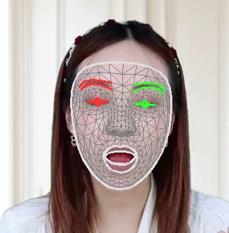开源的跨平台AI模型部署总有一款是你的菜
Posted 修炼之路
tags:
篇首语:本文由小常识网(cha138.com)小编为大家整理,主要介绍了开源的跨平台AI模型部署总有一款是你的菜相关的知识,希望对你有一定的参考价值。
导读
Mediapipe是Google开源的一个跨平台模型部署项目

除此之外,Mediapipe还提供了大量的开源模型

我们能够很方便的使用MediaPipe将模型部署在android、ios、Desktop、Web以及IOT设备上。接下来我们看看如何使用MediaPipe来部署我们的模型
安装MediaPipe
MediaPipe支持在多个平台以及多种编程语言使用,这里就不一一介绍了,主要介绍在python安装方法
#创建虚拟环境,建议使用python3.7的环境
conda create -n mp_env python==3.7
#激活环境
source activate mp_env
#安装mediapipe
pip install mediapipe
使用MediaPipe实现人脸关键点检测
这里我们主要使用Face Mesh这个项目在Python上为例来介绍如何使用MediaPipe,更多其它的项目请参考MediaPipe的Solutions
Face Mesh是用来检测人脸的3D landmarks,它一共检测了468个人脸关键点,它能够实时的运行在移动设备上。利用检测到的468个人脸关键点,我们可以做出很多好玩的AR特效

- Python检测3D landmarks
import cv2
import mediapipe as mp
mp_drawing = mp.solutions.drawing_utils
mp_drawing_styles = mp.solutions.drawing_styles
mp_face_mesh = mp.solutions.face_mesh
#检测单张图片的人脸3D landmarks
#用来存放图片的路径
IMAGE_FILES = []
#设置绘制点线的粗细和点的半径
drawing_spec = mp_drawing.DrawingSpec(thickness=1, circle_radius=1)
with mp_face_mesh.FaceMesh(
static_image_mode=True,#设置图片检测人脸landmarks
max_num_faces=1, #最多检测一个人脸
refine_landmarks=True,
min_detection_confidence=0.5) as face_mesh:
for idx, file in enumerate(IMAGE_FILES):
#读取图片
image = cv2.imread(file)
#图片的预处理,将BGR格式的图片转为RGB
results = face_mesh.process(cv2.cvtColor(image, cv2.COLOR_BGR2RGB))
if not results.multi_face_landmarks:
continue
annotated_image = image.copy()
#在图片上绘制landmarks
for face_landmarks in results.multi_face_landmarks:
print('face_landmarks:', face_landmarks)
#绘制网格线
mp_drawing.draw_landmarks(
image=annotated_image,
landmark_list=face_landmarks,
connections=mp_face_mesh.FACEMESH_TESSELATION,
landmark_drawing_spec=None,
connection_drawing_spec=mp_drawing_styles
.get_default_face_mesh_tesselation_style())
#绘制连的轮廓
mp_drawing.draw_landmarks(
image=annotated_image,
landmark_list=face_landmarks,
connections=mp_face_mesh.FACEMESH_CONTOURS,
landmark_drawing_spec=None,
connection_drawing_spec=mp_drawing_styles
.get_default_face_mesh_contours_style())
#绘制虹膜
mp_drawing.draw_landmarks(
image=annotated_image,
landmark_list=face_landmarks,
connections=mp_face_mesh.FACEMESH_IRISES,
landmark_drawing_spec=None,
connection_drawing_spec=mp_drawing_styles
.get_default_face_mesh_iris_connections_style())
#保存绘制后的图片
cv2.imwrite('/tmp/annotated_image' + str(idx) + '.png', annotated_image)
# 利用电脑的摄像头来检测人脸的landmarks
drawing_spec = mp_drawing.DrawingSpec(thickness=1, circle_radius=1)
cap = cv2.VideoCapture(0)
with mp_face_mesh.FaceMesh(
max_num_faces=1,
refine_landmarks=True,
min_detection_confidence=0.5,
min_tracking_confidence=0.5) as face_mesh:
while cap.isOpened():
success, image = cap.read()
if not success:
print("Ignoring empty camera frame.")
# If loading a video, use 'break' instead of 'continue'.
continue
# To improve performance, optionally mark the image as not writeable to
# pass by reference.
image.flags.writeable = False
image = cv2.cvtColor(image, cv2.COLOR_BGR2RGB)
results = face_mesh.process(image)
# Draw the face mesh annotations on the image.
image.flags.writeable = True
image = cv2.cvtColor(image, cv2.COLOR_RGB2BGR)
if results.multi_face_landmarks:
for face_landmarks in results.multi_face_landmarks:
mp_drawing.draw_landmarks(
image=image,
landmark_list=face_landmarks,
connections=mp_face_mesh.FACEMESH_TESSELATION,
landmark_drawing_spec=None,
connection_drawing_spec=mp_drawing_styles
.get_default_face_mesh_tesselation_style())
mp_drawing.draw_landmarks(
image=image,
landmark_list=face_landmarks,
connections=mp_face_mesh.FACEMESH_CONTOURS,
landmark_drawing_spec=None,
connection_drawing_spec=mp_drawing_styles
.get_default_face_mesh_contours_style())
mp_drawing.draw_landmarks(
image=image,
landmark_list=face_landmarks,
connections=mp_face_mesh.FACEMESH_IRISES,
landmark_drawing_spec=None,
connection_drawing_spec=mp_drawing_styles
.get_default_face_mesh_iris_connections_style())
# Flip the image horizontally for a selfie-view display.
cv2.imshow('MediaPipe Face Mesh', cv2.flip(image, 1))
if cv2.waitKey(5) & 0xFF == 27:
break
cap.release()

- 其它语言的代码
javascript和Android的源码请参考代码示例
参考
- https://github.com/google/mediapipe
- https://google.github.io/mediapipe/solutions/face_mesh.html
- https://google.github.io/mediapipe/
以上是关于开源的跨平台AI模型部署总有一款是你的菜的主要内容,如果未能解决你的问题,请参考以下文章
Flutter 2.2 发布 | 各平台优化类型别名云部署能力UWP Alpha,总有一款是你的菜
零代码工具15 款企业级零代码开发平台推荐,总有一款是你心仪的